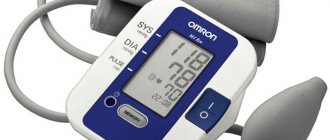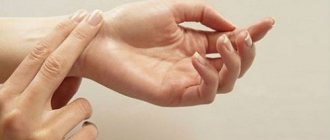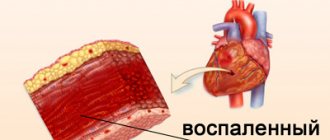Most people are accustomed to thinking that blood pressure (BP) levels need to be monitored only by people over 40 years of age. This opinion arose due to the frequent appearance of the term “hypertension”, meaning an increase in blood pressure levels above normal. Indeed, hypertension is more typical for older patients, however, this pathological condition can occur in representatives of every age group.
There is another concept - “hypotension”, which means a decrease in blood pressure below normal. It occurs more often in children and adolescents, as well as young women. That is why periodic monitoring of blood pressure levels should be carried out for representatives of any age category, including the youngest. Further in the article, we consider what the normal blood pressure is in children of different ages, why it needs to be controlled, and what factors influence the deviation of indicators from the norm.
What is pressure and what does it depend on?
The flow of blood through the vessels of the human body occurs due to its release from the heart and the pressure difference in vessels of different diameters (arteries, veins and capillaries). With each contraction of the heart muscle, a certain amount of blood is released under pressure into the aorta (the largest artery) and the pulmonary trunk. The rhythmic work of the heart ensures periodic fluctuations in blood pressure levels: an increase in values during contraction (systole) of the heart and a decrease during the period of relaxation (diastole).
The highest numbers are recorded during systole, which is why this pressure is called systolic (upper), the minimum during diastole, which means this pressure is called diastolic (lower). Blood pressure levels depend on the age group of the population a person belongs to. Blood pressure in children is lower than in adults. This is explained by the fact that in children and adolescents the walls of the arteries are more elastic.
And also lower rates in childhood are explained by low vascular tone, the presence of short and straight capillaries, as a result of which peripheral resistance decreases. During puberty, a number of changes occur in the body, during which the adolescent’s heart grows faster than the blood vessels. As a result, so-called juvenile hypertension occurs, in which the upper pressure increases to 140 mm Hg. Art., however, this condition is temporary.
No ads 1
Diagnostics
The main diagnostic method is tonometry: regular, several times a day. Adolescence is one of the stages of growing up, so symptoms that often arise are attributed to hormonal changes. However, a recorded increase or decrease in blood pressure at least three times in a row should make parents think, seek advice from a pediatrician, and conduct a full examination of the teenager, the algorithm of which is standard:
- history taking, physical examination;
- UAC, OAM:
- biochemical blood testing for all indicators prescribed by a specialist;
- ECG;
- Ultrasound.
The point is to establish the root cause of blood pressure fluctuations. If necessary, the doctor may order additional tests to clarify the diagnosis.
Indicators in a newborn and infant
What blood pressure should a child have under one year of age (mm Hg):
- From birth to 14 days – 60-95 (systolic), 40-50 (diastolic).
- From 14 days to 1 month – 80-115 (systolic), 40-75 (diastolic).
- From 1 month to 1 year – 90-115 (systolic), 50-75 (diastolic).
Neonatological and pediatric standards say that you can quickly calculate whether the systolic pressure is normal in a child under one year old using the following formula: 76 + 2n, where n means the baby’s age in months. The diastolic reading should be 1/3–1/2 of the systolic reading.
Standard “home” tonometers are not used to measure blood pressure in newborns
In newborns, a sharp decrease in blood (arterial) pressure is often associated with the development of a state of shock, the causes of which may be:
How to measure your own blood pressure with a mechanical tonometer
- Internal bleeding.
- Birth injury.
- Sepsis.
- Hemolytic disease of newborns (edematous form).
- Severe form of asphyxia.
- Congenital heart defects.
- Severe respiratory distress syndrome.
- Heart failure.
- Hemorrhage into the adrenal gland.
- Pneumothorax, etc.
In such cases, in addition to a decrease in blood pressure, the child experiences pale skin, an increase or, conversely, a decrease in heart rate, and shortness of breath. The lower extremities become cold, urine output is sharply reduced or completely absent.
Important! Most often, a decrease in blood pressure is observed in premature sick children.
Arterial hypertension (increased blood pressure) is not typical for full-term babies who were born healthy. The pathological condition is considered secondary, since it occurs against the background of certain diseases, for example, pathology of the renal apparatus and ureters, patent ductus arteriosus, bronchopulmonary dysplasia. Blood pressure increases in a newborn if the mother took steroid drugs during pregnancy or the baby was prescribed indomethacin after birth.
Symptoms of increased blood pressure in a newborn include irritability and general restlessness, unmotivated crying, shortness of breath and attacks of apnea (short-term cessation of breathing), and convulsions. Adequately selected treatment can return the child’s blood pressure to normal.
No ads 2
Blood pressure in a child from 1 year to 12 years
The level of blood pressure in the period from 1 year to 5 years practically does not change. Average systolic pressure is 100–115 mm Hg. Art., diastolic – 60–75 mm Hg. Art. Normal baby blood pressure:
- From 6 to 9 years – 100–125/60–80 mmHg. Art.
- From 9 to 12 years – 110–125/70–85 mm Hg. Art.
The formula for calculating upper blood pressure in children after one year is: 90+2n, where n means the number of years. Diastolic should be 1/3–1/2 of the upper value. Up to 5 years of age, blood pressure levels do not depend on gender differences. 6–9 years is the period when boys’ numbers increase by 2–5 mm Hg. Art. more than for girls, and for 9–12 years old it is the other way around.
A persistent increase or decrease in indicators should be alarming, since children usually do not suffer from primary forms of arterial hypo- and hypertension. Any recorded numbers must be rechecked several times throughout the day.
Hypotension
If there are no clinical manifestations, you can think about the physiological variant of hypotension, which does not require medical intervention. This occurs in children with asthenic physique, as well as those who play sports or move actively throughout the day. The pathological form of the condition is manifested by weakness, decreased performance, lack of desire to do favorite things, dizziness, and increased heart rate.
The reasons for a decrease in blood pressure in children aged 1 to 12 years can be various types of anemia, blood loss of varying intensity, pathologies of the thyroid gland, adrenal insufficiency, heart and vascular diseases, as well as overdose of certain medications. The danger of the condition lies in the slowing of blood circulation, which, in turn, leads to the fact that the body tissues do not receive enough oxygen.
Hypertension
There are two main forms of hypertension: primary, the cause of which could not be reliably determined, and secondary, the provoking factor of which was a specific disease. The danger of increased blood pressure is possible damage to the heart, kidneys, retina and brain. And the risk of stroke and heart attack also increases significantly. For a long period of time, parents may not even suspect that their child is developing hypertension.
A sedentary lifestyle is a factor influencing changes in blood pressure readings
Characteristic symptoms:
- Headache.
- Dizziness.
- Sensation of pulsation in the temples.
- Noise and ringing in the head.
- The appearance of "floaters" before the eyes.
Later, visual acuity may decrease, the number of trips to the toilet becomes more frequent, and painful sensations appear in the heart area.
Indications for daily blood pressure measurement
Younger schoolchildren are very active and easily excitable, so a single blood pressure measurement in a doctor’s office is not always enough to make a diagnosis. To prevent mistakes, the child may be prescribed 24-hour monitoring.
Indications for daily monitoring are:
- type 1 diabetes;
- kidney disease;
- performed heart, liver or kidney transplantation;
- assessment of the effectiveness of a previously developed therapeutic treatment regimen for diseases of the heart, kidneys, and brain.
Teenage years
We are talking about the age of 12–15 years. Normal numbers during this period can be seen in the table.
| Age | Upper (mm Hg) | Lower (mmHg) | ||
| Minimum | Maximum | Minimum | Maximum | |
| 12, 13, 14, 15 years | 110 | 135 | 70 | 85 |
In parallel with blood pressure readings, it is necessary to measure the heart rate (pulse). For the puberty period, the optimal numbers are 55–95 beats/min. Imperfect regulation of autonomic functions, which is typical for adolescence, explains frequent surges in blood pressure. At this time, the body of boys and girls experiences serious overloads, which are also reinforced by changes in hormonal levels. Changes in blood pressure in adolescents are manifested by both its increase and decrease.
In girls, hypertension can be observed from the age of 12, in boys - later, from the age of 14. The most common cause is probably excess levels of adrenaline and aldosterone. A large amount of hormones provokes vasoconstriction, which causes the development of hypertension. Symptoms of the condition may be absent or mild. Provoking factors are also considered to be an irregular daily routine, insomnia, spending a lot of time at the computer, and excessive stress on the body (for example, participation in sports competitions).
Hypotension can also be observed in completely healthy children, for example, after overeating, when being in a stuffy room, in adolescents with an asthenic body type. Low physical activity and prolonged exposure to stress can also be reasons.
No ads 3
Recording indicators
Diagnosis of arterial hypo- or hypertension is based on threefold measurement of indicators. To correctly measure blood pressure in children, it is necessary to select a tonometer according to the child’s age. The table values will help you choose the optimal cuff width, according to the All-Ukrainian Health Organization.
| Age category | Cuff width (cm) |
| Newborns and infants | 2,5 |
| 1–3 years | 5–6 |
| 4–7 years | 8–8,5 |
| 8–9 years | 9 |
| 10–13 years | 10 |
| 14–16 years old | 13 |
How to measure blood pressure in children and adolescents:
- It is necessary to give the child time to adapt to the conditions in which the measurement will take place (5–10 minutes).
- The arm on which the measurement will be taken should be at heart level, the back should rest against the back of the chair, and the legs should not be crossed. The sleeve should not squeeze the arm above the place where the cuff is fixed.
- The stethoscope is applied to the area of the ulnar fossa at the site of the projection of the brachial artery.
- The cuff is fixed 2.5 cm above the cubital fossa. Close the bulb valve, making sure that the readings are at 0 mmHg. Art.
- Inflate air into the cuff until the pulsation disappears, adding 20–30 mmHg. Art. Next, the valve of the bulb is slowly opened, carefully monitoring the number at which the pulsation becomes audible again. This is the first indicator - systolic pressure.
- The moment the pulsation disappears is the second indicator (diastolic pressure).
- Record the indicators on paper or in medical documentation.
Volume of liquid for gastric lavage
| Age | Single (ml) | Total (ml) |
| Newborn | 15-20 | 100 |
| 1 – 6 months | 60-100 | 500 |
| 7-12 months | 110-150 | 1000 |
| 2-5 years | 200-350 | 3000-5000 |
| 6-10 years | 350-450 | 6000-8000 |
| 11-15 years | 450-600 | 6000-10000 |
| Adults | 5-10 ml/kg | 2-5-10x |
How to avoid blood pressure surges in children
It is important to follow the following recommendations from experts. First of all, it is necessary to change the child’s daily routine, spend more time in the fresh air, get full sleep at night; daytime sleep is also important for children. In the morning, it is advisable to do light exercises so that the body has time to wake up.
Blood pressure is an important indicator that must be monitored even in childhood
The next step is to normalize your diet. Children, left without parental control, love to eat fast food, chips, and nuts. It is important to explain that such food is not good for the body. You should increase the amount of fruits and vegetables consumed, cereals, dairy products, and reduce salt intake (the last recommendation for hypertensive patients).
If you are prone to hypertension, massage of the collar area, head and face is useful. For hypotension – lumbar region, abdomen, buttocks and lower extremities. And experts also recommend paying attention to water procedures: for hypertension, warm baths with herbal infusions and decoctions are considered useful; for hypotension, on the contrary, a contrast shower is needed, which will have a tonic effect. And experts may also advise giving the child medications that are prescribed on an individual basis.











